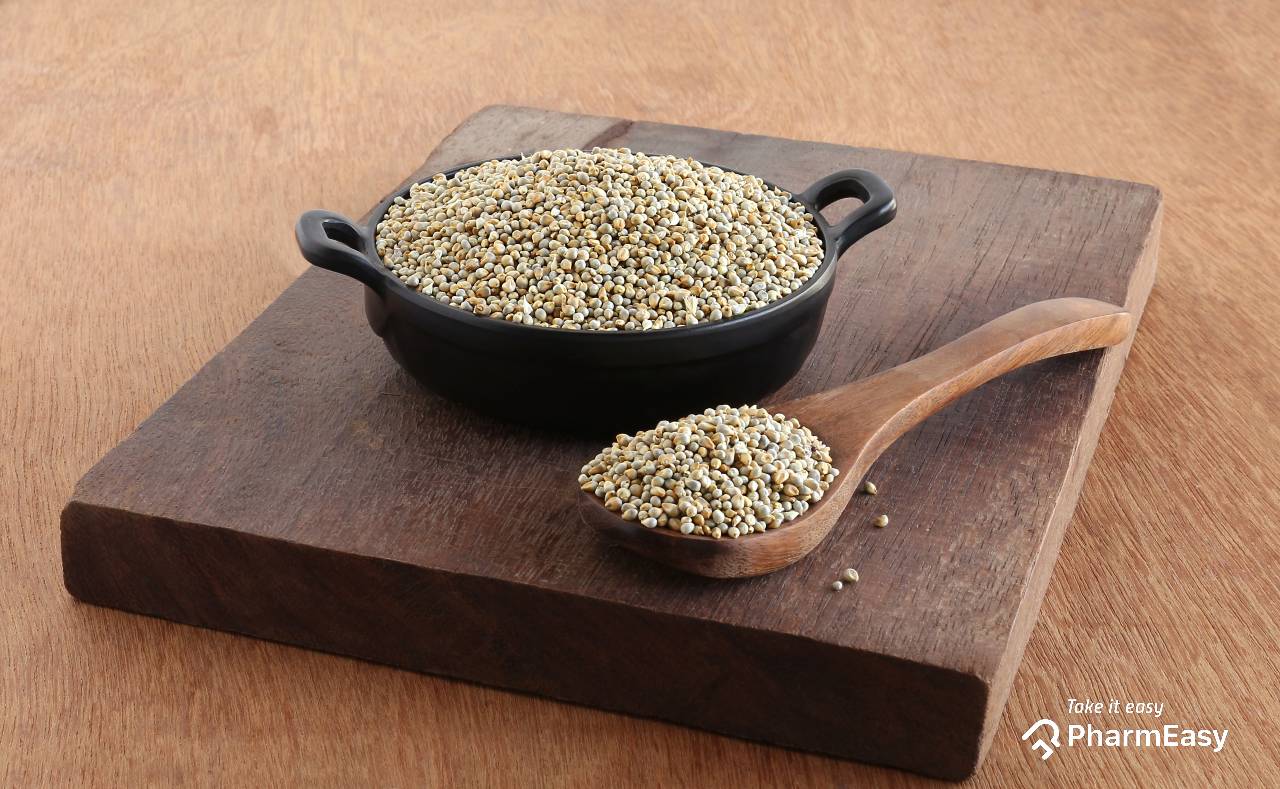12 Nutritional Benefits Of Bajra (Pearl Millets)
By Mansi Shah +2 more

Get,

to manage your symptom
Get your,


4 Cr+ families
benefitted

OTP sent to 9988776655



You’ve successfully subscribed to receive
doctor-approved tips on
Whatsapp

Get ready to feel your best.

Hi There,
Download the PharmEasy App now!!


Register to Avail the Offer
Send OTPBy continuing, you agree with our Privacy Policy and Terms and Conditions

Hi There,
Sign up on PharmEasy now!!
Trusted by 4 crore+ families

OTP sent to 9988776655



You have unlocked 25% off on medicines




Code: NU25
By Mansi Shah +2 more
Table of Contents
If you are looking for healthy options to fill your plate, there are several types of dietary cereals available which can prove to be an appropriate choice. And one such healthy cereal is Bajra, a grain rich in fibres, micronutrients, vitamins, and amino acids.
Commonly categorized as millets, this grain possess numerous nutritional qualities and is good for consumption by all age groups of people, including infants, elderly, pregnant, and nursing mothers. There are some other variants of millets too, such as Sorghum (Jowar), Finger Millets (Ragi/Nachni), Proso Millets, Foxtail Millets, Little Millets (samai) that are used in various forms across the globe to enhance the nutritional value of regular meals1. However, bajra is commonly produced and consumed in India and is proposed to have several health benefits. It can help in managing diabetes by regulating blood sugar levels and also supports bone health. It is rich in antioxidants that help in protecting the body against chronic diseases2.

In this blog, we will discuss in detail about the nutritional value and health benefits of this marvel food.
Pearl Millet, commonly known as bajra is a profoundly nutritious and easy-to-digest cereal grain. Being non-glutinous makes it a healthy option for people with a gluten allergy and celiac disease. They are power-packed with carbohydrates, essential amino acids, antioxidants, multiple vitamins like thiamine, riboflavin, folic acid, niacin, beta carotene, and minerals like iron, phosphorus, magnesium, and zinc1.
Let me tell you about the special compounds in Bajra that might help manage diabetes. These compounds, called phenolic compounds, have antidiabetic activity, meaning they may help control blood sugar levels. That’s why pearl millet might be used to make a range of tasty food products suitable for people with diabetes2.
Dr. Siddharth Gupta, B.A.M.S, M.D (Ayu)
Per 100 gm of Pearl Millet Contains:
In my opinion, adding Bajra to your diet can be a smart and tasty choice! It might be great for people with high cholesterol. It contains a special compound called phytic acid that may help regulate cholesterol metabolism and keep it balanced in the body9.
Dr. Rajeev Singh, BAMS
Owing to their rich nutritional value, bajra or pearl millets have several health benefits. These include:
While the health benefits of bajra are mostly backed by scientific research, further large-scale human trials are needed to help corroborate the promising findings.
Based on my observations, including Bajra in your diet might be a natural way to support gallbladder health and reduce the chances of gallstone formation. When our intestines produce too much bile, it may worsen the condition of gallstones. The insoluble fibre found in pearl millet might help reduce the production of excess bile in our digestive system. It is high in fibre, which may also help reduce the risk of developing gallstones9.
Dr. Smita Barode, B.A.M.S, M.S.
Also Read: Poha: Uses, Benefits, Side Effects & More
Pearl millets or bajra can be found in various forms for daily consumption. You can use it as flour to make flatbreads or dosa, grains to make porridge, processed grains as poha or upma for breakfast, and ready to eat snacks like millet or multigrain cookies. The potential health benefits of bajra make it a perfect superfood, optimum for regular consumption by all.
You can combine your favourite millet recipe with protein-rich dishes containing lentils, cottage cheese, soya chunks, and some fresh fruits, and a vegetable smoothie or salsa to make a perfect platter of the recommended balanced diet.
In my opinion, Bajra may help in managing anaemia and increasing haemoglobin levels. Bajra is rich in iron, containing about 8mg of iron per 100g. Thus, by including Bajra in your diet, you may boost your iron intake and support healthy haemoglobin levels10.
Dr. Anuja Bodhare, B.A.M.S, M.D (Ayu)
Also Read: Urad Dal: Uses, Benefits, Side Effects, and More!
Bajra is a wonder cereal that is rich in essential nutrients, dietary fibre, proteins and even antioxidants. It has several health benefits ranging from healthy digestion to diabetes control as well as lowering risks of many diseases like high blood pressure and cardiovascular issues. It can therefore make up as a great component of a healthy and balanced diet. However, it’s important to note that like any other food item, bajra must also be consumed in moderation and incorporated in routine diet after doctor consultation in case you have any medical problems.
Also Read: Amazing Health Benefits of Makhana (Fox Nuts)
Disclaimer: The information provided here is for educational/awareness purposes only and is not intended to be a substitute for medical treatment by a healthcare professional and should not be relied upon to diagnose or treat any medical condition. The reader should consult a registered medical practitioner to determine the appropriateness of the information and before consuming any medication. PharmEasy does not provide any guarantee or warranty (express or implied) regarding the accuracy, adequacy, completeness, legality, reliability or usefulness of the information; and disclaims any liability arising thereof.
Comments

Leave your comment...
You may also like
Comments